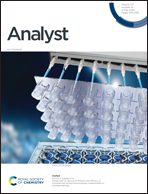Isomeric separation of permethylated glycans by extra-long reversed-phase liquid chromatography (RPLC)-MS/MS†
Abstract
Glycosylation is known as a critical biological process that can largely affect the properties and the functions of proteins. Glycan isomers have been shown to be involved in a variety of disease progressions. However, the separation and identification of glycan isomers has been a challenge for years due to the microheterogeneity of glycan isomeric structures. Therefore, effective and stable techniques have been investigated over the last few decades to improve isomeric separations of glycans. RPLC has been widely used in biomolecule analysis because of its extraordinary reproducibility and reliability in retention time and separation resolution. However, so far, no studies have achieved high resolution of glycan isomers using this technique. In this study, we focused on further boosting the isomeric separation of permethylated glycans using a 500 mm reversed-phase LC column. To achieve better resolutions on permethylated glycans, different LC conditions were optimized using glycan standards, including core- and branch-fucosylated N-glycan isomers and sialic acid linked isomers, which were both successfully separated. Then, the optimal separation strategy was applied to achieve separations of N- and O-glycan isomers derived from model glycoproteins, including bovine fetuin, ribonuclease B and κ-casein. Baseline separations were observed on multiple sialylated linkage isomers. However, the separation performance of high-mannose isomers needs further improvement. The reproducibility and stability of this long C18 column was also tested by doing run-to-run, day-to-day and month-to-month comparisons of retention times on multiple glycans and the %RSD was found less than 0.92%. Finally, we applied this approach to separate glycan isomers derived from complex biological samples, including blood serum and cell lines, where baseline separations were attained on several isomeric structures. Compared to the separation efficiency of PGC and MGC columns, the RPLC C18 column provides lower resolution but more robust reproducibility, which makes it a good complementary alternative for isomeric separations of glycans.



 Please wait while we load your content...
Please wait while we load your content...